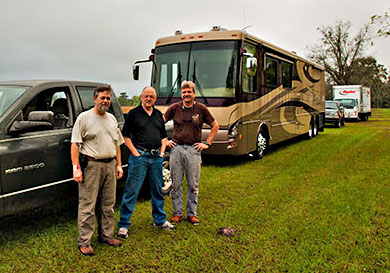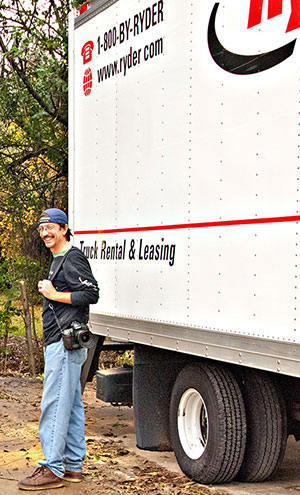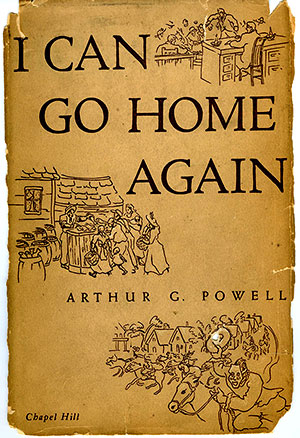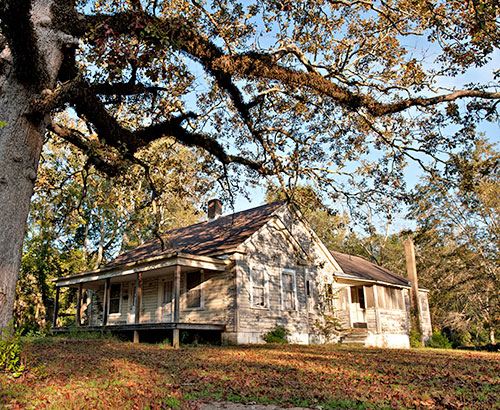|
|
The Blakely Burl Tree Project: The
Story
|
The Blakely Burl Tree Project:
From The Ground Up
by Terry Martin |
THE HARVEST
THE ROAD TO BLAKELY
It is a Saturday in late November
2009, and the rain mists down out of a humid sky as we trail in a convoy of four
vehicles to Blakely, Georgia. The first vehicle is Mark Lindquist’s pickup and
Mark is guiding the team from his home in Quincy, Florida, to Blakely in south
Georgia. We are going to work on a project that promises to be unlike any other
project we have ever worked on.
Mark is the driving force behind the Blakely Burl Tree Project (BBTP). Charles
Rice challenged Mark to create a new project that would fit in with the
objectives of his Early County 2055 project and Mark has come up with a
timetable that will challenge us all over the coming two weeks.
|
|

|
Mark Lindquist (left), Terry Martin,
(center), Gary
Stevens, (right)
Photo: John McFadden
|
|
The next vehicle is an enormous motor home driven by Gary Stevens, the “harvest
master.” This huge vehicle will become our on-site mission control and project
office. Gary is a construction superintendent from Santa Cruz, California, and
he is the harvest master for the BBTP. There are two things that make Gary the
right man for the job. Firstly, his work in the construction industry means that
he understands machinery and how to lead a team. Gary is also one of the most
successful wood artists in the United States. His energy and know-how will prove
invaluable.
I follow behind in John McFadden's pickup, bouncing all over the back country
roads in the turbulent wash of the motor home. John is our photographer and in
the back is all of John’s equipment. I'm here from Brisbane, Australia, to
record and write about our time in Georgia. I only heard about the project from
Mark a few weeks ago and I flew into Florida yesterday. Mark is good at
convincing people to do what he wants. Despite visiting the USA more times than
I can remember since 1969, I have never been this far south before and I am
fascinated by the countryside.
At the tail end is John himself, driving a rental truck loaded with every piece
of equipment imaginable, from a range of chainsaws to heavy rigging tackle, and
from studio lighting to folding tables. Originally from Texas, now John lives in
Minnesota, but spends a lot of his time working with Mark on a range of
assignments. I’ve long admired John’s photography and he is gifted with an
insatiable desire to create unique images. |
|
|
 |
| |
|
John McFadden, photographer -
Photo: M. Lindquist |
 |
|
As we track and backtrack from state highways to small country roads, we cut
through a large slice of the extreme southwestern corner of the state of
Georgia. I am fascinated as the country unfolds because a few weeks before Mark
had sent me a copy of I Can Go Home Again, a book written in 1943 by a favorite
son of Blakely, Arthur G. Powell. He was a famous judge who lived and worked in
Atlanta, but his book was about the very country we were driving through and
particularly about Blakely, where he was born in 1873. |
I wanted to see if the land still resembled his description from those wartime
years. Just like us, he had traveled from Florida and he speaks of the
countryside in glowing words:
In the pastures the cows grazed, and pigs grunted and rooted the ground.
Roosters crowed and hens cackled in the barnyards. The farmhouses were neat and
well kept. On the brow of a hill stood a modern brick schoolhouse. Here and
there the steeple of a newly painted church rose above the grove of a country
churchyard.
|

Georgia country farmhouse
Photo: John
McFadden |
I see that we are traveling through good land. The soon-to-be picked cotton
looks like it will be a good harvest, the forests are thick and healthy, and we
often pass trucks loaded with pine logs on the way to the mill. All the signs of
a healthy countryside are still there, but somehow it is not like the picture
Powell painted. Instead of newly painted churches, we pass a lot of tiny,
run-down roadside chapels in sore need of paint. Many of the farmhouses we pass
are derelict and their barns lean all awry in that sad way of wooden buildings
returning to the earth. We see old trailer homes surrounded by weed-filled yards
full of rusting car bodies. Occasionally we pass a shack with a few people
sitting on the porch watching the cars go by. The air of depression is at odds
with the quality of the land.
Like many rural areas in the post-industrial era, we are passing through
collateral damage of globalization. Powell had described how in his lifetime he
had seen this part of the USA “…rise from primitive conditions to a state of
prosperity and culture.” Sadly, we are seeing the same country after decades of
reversals.
|
<BACK
| NEXT>
|